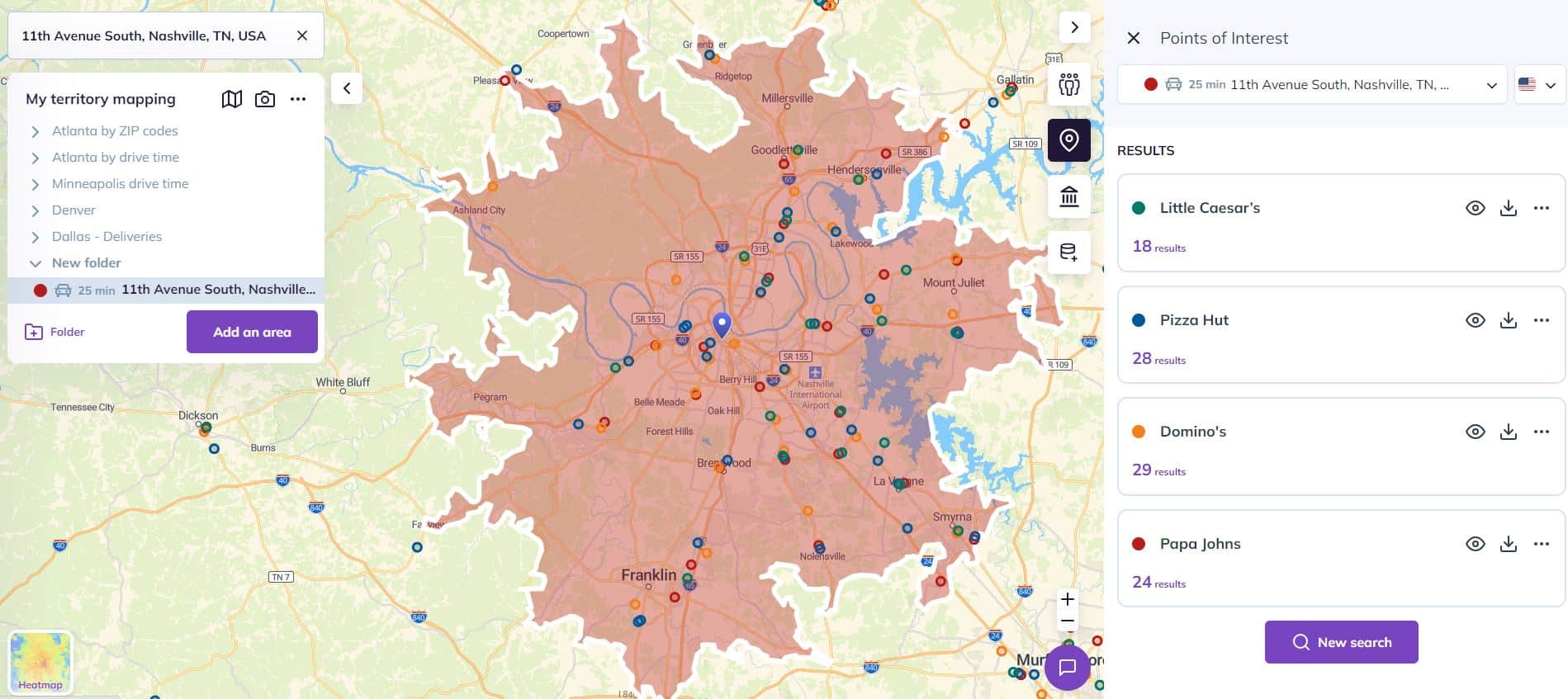Now that you know the 5 reasons why you should define your franchise territories, and also when you should define them, let’s party!
Ahah. OK. There is a little bit more of work before selling your territories to your future franchisees.
In order to have the perfect franchise territories, you should know what criteria are a key to your brand’s success. Follow the guide!
⚠️ Heads up!
Before diving headfirst into this journey, laying the right groundwork is crucial. And that begins with a clear understanding of your existing, reference locations and your typical area of influence.
Know your reference locations
Think of it this way: you wouldn’t set sail on a voyage without a map and a good grasp of the waters you’re navigating. Similarly, before defining the success criteria for your franchise’s market analysis, knowing your successful and not-so-successful locations is essential. These locations aren’t just pins on a map; they’re a goldmine of insights, embodying what works and what doesn’t for your brand.
Know your typical area of influence
Equally important is understanding your typical area of influence. Whether you’re running a cozy coffee shop downtown or a mobile dog-grooming service, grasping how far your influence extends is pivotal. This knowledge shapes the boundaries of your potential franchise territory, ensuring that your expansion efforts aren’t just shots in the dark.
This understood (and we will explain how to know these 2 characteristics in next blog posts), our goal here is to guide you through the crucial steps of defining effective success criteria.
These steps will help evaluate the suitability of a geographic area for your franchise’s growth.
- Defining the ideal customer profile (ICP)
- Quantifying key success factors
- Looking at others criteria
So, buckle up, and let’s embark on this journey of strategically mapping out your path to franchise success.
Defining the Ideal Customer Profile (ICP)
Let’s turn the spotlight on a game-changer in franchise success: the Ideal Customer Profile (ICP). You might be wondering, “What’s all the fuss about ICP?” Well, imagine having a compass that points you exactly where you need to go. That’s what a well-crafted ICP does for your franchise. It’s not just about who might walk through your door; it’s about knowing who you want to walk through that door.
Identifying the key characteristics of your target customers is like assembling a puzzle.
1. What to look for
You’re looking for pieces that fit:
- demographics like age, income, gender, family size, education… (for B2C goals)
- or the type of business like industries, job title, company size… (in B2B scenarios)
2. How to find it
How do you find these pieces?
2 possibilities (that can be fusioned)
- Customer data: dive into your CRM. It’s a treasure trove of insights.
- Existing locations: Analyzing data from your existing locations can reveal patterns and trends that you might miss at first glance. It’s where you need to know which locations are the best to analyze and which are not. Also how you can size these territory to pull out demographics and business infos.
The trick is to not just gather data, but to read the story it tells. Which locations are buzzing with activity? What do these customers have in common?
By connecting these dots, you’re not just guessing who your ideal customer is; you’re scientifically crafting a profile that can significantly steer your franchise towards success. And in the world of franchising, having this kind of clarity isn’t just nice to have; it’s a cornerstone of smart expansion.
Quantifying key success factors
Quantifying key success factors plays a pivotal role: it’s about turning abstract ideas into concrete numbers that can guide your decision-making.
Think of it as setting the benchmarks for what makes a territory viable. But how do you determine these magic numbers? The answer lies in a deep dive into the data from your existing locations.
Let’s break it down.
From your most successful locations
Start by examining your most successful locations.
What do they have in common? Maybe it’s a bustling population of over 50,000 or a median household income above a certain threshold. These aren’t just random figures; they are the lifelines of your successful ventures. But don’t stop there.
From your least successful locations
It’s equally important to learn from the locations that didn’t fare as well.
Understanding why some areas didn’t hit the mark can provide crucial insights into setting your performance thresholds.
Quantifying these factors is not just about drawing a line in the sand. It’s a strategic move to ensure that each new franchise has the fighting chance it deserves.
By identifying these quantifiable success factors, such as housing density or average income, you set a clear, data-driven path for future expansions. This approach ensures that your growth is grounded in reality, providing a roadmap for replicating success in new territories.
Whereas your Ideal Customer Profile, the key success factors consists in knowing how many people in your ICP you need in your influence area and their specifity.
For example: at least 50 000 family households with an income > 50k$
One tip from our customer Tom Dufore, CEO of Big Sky Franchise Team: “As for metrics, starting with the total population tends to be the easiest approach. To delve deeper, I generally advise looking at your customer base and using that as a key driver.”
Considering additional success factors in your neighborhood
Nearby brands can be a boon or a bane.
Beyond the numbers and customer profiles, there’s a landscape of additional factors that can significantly impact your franchise’s success. It’s about understanding the ecosystem around your potential location.
Complementary businesses with similar targets
Aligning with businesses that attract a similar clientele can create a synergy, drawing in a steady flow of your target audience.
Presciptors or referrers
Prescriptors, or businesses and entities that can recommend your services, add another layer to the strategic location puzzle. Their presence can be a strong indicator of a supportive business environment.
Direct or indirect competitors
Being too close to direct competitors can be challenging, unless you’re confident in your franchise’s unique value proposition. But they can be also a good indicator of a rich market for you, especially for indirect competitors.

In this strategic evaluation, the key is balance and foresight.
It involves not just seeing the immediate effects but anticipating the long-term dynamics of your franchise’s location. These additional factors require careful consideration and, when aligned correctly, can turn a good location into a great one, cementing the foundation for long-term success.
A little bit lost? Follow our example step-by-step
Let’s follow this example!
“Green Crust” is an innovative vegan bakery brand. Green Crust specializes in a range of delicious, plant-based baked goods, offering everything from artisanal sourdough breads to decadent vegan pastries. The brand combines a commitment to sustainability with a modern, inviting café atmosphere.
Here’s how Green Crust would follow the steps for franchise expansion:
Example: Green Crust's Vegan Bakery Franchise Expansion
Defining the Ideal Customer Profile (ICP) for Green Crust:
- Demographic Analysis:
- Green Crust’s customer data shows that their core clientele are environmentally conscious individuals, predominantly aged 20-40, who prioritize plant-based diets.
- These customers are often found in urban or suburban areas with a strong presence of health and wellness communities.
- Market Research:
- The brand conducts surveys and collects feedback from its most successful locations, revealing a high demand in neighborhoods with yoga studios, organic grocery stores, and universities.
Quantifying Key Success Factors:
- Analysis of Successful Locations:
- Locations in environmentally conscious neighborhoods, with a high percentage of young professionals and students, show the highest footfall and sales.
- Areas with a minimum population of 10,000 people aged 20-40 within the trade area and an average household income of over $60,000 are identified as prime locations.
- Learning from Challenging Locations:
- Locations that struggled were often in areas with lower awareness of vegan lifestyles or limited access to vegan-friendly products with family revenue less stronger.
Considering Additional Success Factors:
- Community Presence:
- Green Crust seeks locations near community centers, fitness studios, and other businesses that align with a vegan, eco-friendly lifestyle.
- Local Partnerships:
- The brand looks for opportunities to collaborate with local farmers’ markets and vegan product suppliers to strengthen its community ties and product authenticity.
- Market Dynamics:
- While direct competition with other vegan bakeries is considered, Green Crust also evaluates the presence of traditional bakeries as an indicator of a vibrant market.
It's not just about analysis and numbers
As we draw this guide to a close, remember that defining your territory franchise’s winning criteria isn’t just about analysis and numbers; it’s about crafting a vision for your brand’s future. From understanding your reference locations and their zones of influence to pinpointing the exact profile of your ideal customer, each step is a crucial piece of the puzzle in building a successful franchise model.
The journey through defining the Ideal Customer Profile (ICP), quantifying key success factors, and considering additional criteria, is more than just groundwork. It’s a strategic blueprint for replication and growth. You’re not only setting up the foundations for where your franchise can thrive but also understanding the intricate dynamics of the market and consumer behavior.
With these insights, you’re equipped to make informed decisions, tailor your expansion strategies, and replicate success in new territories. The winning criteria you define today become the stepping stones to the thriving franchise locations of tomorrow.
As you embark on this exciting path of expansion and growth, keep these guidelines close. They will help navigate the complex yet rewarding world of franchise development, ensuring that every new location is a testament to your brand’s resilience, adaptability, and enduring appeal.
Here’s to the success of your franchise journey, one well-defined territory at a time!

